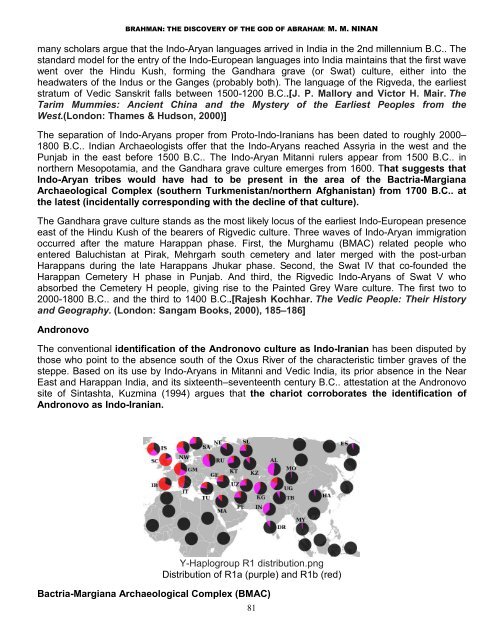Create successful ePaper yourself
Turn your PDF publications into a flip-book with our unique Google optimized e-Paper software.
BRAHMAN: THE DISCOVERY OF THE GOD OF ABRAHAM: M. M. NINAN<br />
many scholars argue that the Indo-Aryan languages arrived in India in the 2nd millennium B.C.. The<br />
standard model for the entry of the Indo-European languages into India maintains that the first wave<br />
went over the Hindu Kush, forming the Gandhara grave (or Swat) culture, either into the<br />
headwaters of the Indus or the Ganges (probably both). The language of the Rigveda, the earliest<br />
stratum of Vedic Sanskrit falls between 1500-1200 B.C..[J. P. Mallory and Victor H. Mair. The<br />
Tarim Mummies: Ancient China and the Mystery of the Earliest Peoples from the<br />
West.(London: Thames & Hudson, 2000)]<br />
The separation of Indo-Aryans proper from Proto-Indo-Iranians has been dated to roughly 2000–<br />
1800 B.C.. Indian Archaeologists offer that the Indo-Aryans reached Assyria in the west and the<br />
Punjab in the east before 1500 B.C.. The Indo-Aryan Mitanni rulers appear from 1500 B.C.. in<br />
northern Mesopotamia, and the Gandhara grave culture emerges from 1600. That suggests that<br />
Indo-Aryan tribes would have had to be present in the area of the Bactria-Margiana<br />
Archaeological Complex (southern Turkmenistan/northern Afghanistan) from 1700 B.C.. at<br />
the latest (incidentally corresponding with the decline of that culture).<br />
The Gandhara grave culture stands as the most likely locus of the earliest Indo-European presence<br />
east of the Hindu Kush of the bearers of Rigvedic culture. Three waves of Indo-Aryan immigration<br />
occurred after the mature Harappan phase. First, the Murghamu (BMAC) related people who<br />
entered Baluchistan at Pirak, Mehrgarh south cemetery and later merged with the post-urban<br />
Harappans during the late Harappans Jhukar phase. Second, the Swat IV that co-founded the<br />
Harappan Cemetery H phase in Punjab. And third, the Rigvedic Indo-Aryans of Swat V who<br />
absorbed the Cemetery H people, giving rise to the Painted Grey Ware culture. The first two to<br />
2000-1800 B.C.. and the third to 1400 B.C..[Rajesh Kochhar. The Vedic People: Their History<br />
and Geography. (London: Sangam Books, 2000), 185–186]<br />
Andronovo<br />
The conventional identification of the Andronovo culture as Indo-Iranian has been disputed by<br />
those who point to the absence south of the Oxus River of the characteristic timber graves of the<br />
steppe. Based on its use by Indo-Aryans in Mitanni and Vedic India, its prior absence in the Near<br />
East and Harappan India, and its sixteenth–seventeenth century B.C.. attestation at the Andronovo<br />
site of Sintashta, Kuzmina (1994) argues that the chariot corroborates the identification of<br />
Andronovo as Indo-Iranian.<br />
Y-Haplogroup R1 distribution.png<br />
Distribution of R1a (purple) and R1b (red)<br />
Bactria-Margiana Archaeological Complex (BMAC)<br />
81


















